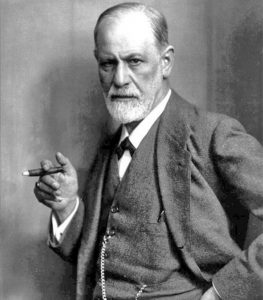In Freud’s Pocket: A Totem of Medical Ambivalence?
by Don R. Lipsitt, MD
In lieu of an abstract, here is a brief excerpt of the content:

How many times have I viewed this iconic photo of Freud, my eye attracted to his sagacious quizzical visage, his well-trimmed beard, the defiantly displayed cigar, his seeming irritation at being photographed, his unruffled three-piece suit with flamboyant watch fob? Although said to be camera-shy, Freud did permit a family friend, Max Halberstadt, to formally photograph him in 1932, seven years before his death at 83, perhaps in anticipation by both of his impending death and legacy.
Viewing the striking photo on this particular occasion, my gaze fixates on some small object protruding from under his jacket, perhaps in an inside vest pocket. My curiosity is piqued. And in venerated psychoanalytic free association mode, I wander and wonder.
The Mysterious Object
My first guess about the hidden object is that it is one earpiece of a binaural stethoscope. But why at his age would he be carrying such an instrument? He had long since abandoned medical practice in favor of a new way of looking at illness, so why would he continue to carry a half-concealed stethoscope? Binaural instruments were in long-time use in his medical school and practice years before this photo was taken. The stethoscope had been invented by the French physician Laennac in 1816; Golding Bird had developed a stethoscope with one earpiece in 1840 that was supplanted mostly by the binaural model soon after in 1852.
Ever since the stethoscope was invented, it became the identifying “trademark” of the medical profession, a symbol of pride of membership in a noble profession. Even retired physicians often retain the prefix of “doctor” with a permanent sense of belonging to a select group. Disaffected physicians do not readily relinquish this identifying affiliation, even with disapproval of their profession’s flaws. Is it possible that, despite Freud’s perennial disaffection with his doctor identity, he had never betrayed his homage to an experiential journey that had, in many ways, sparked his innovative embarkation on a new way of understanding the relationship between mind and body?
Could this be an echo of Freud’s debt to his medical roots? A permanent transitional object, companion to the antiquities on his desk? Pictures of and references to his prized possessions, his consulting room and couch abound, but I have not seen pictures of or read of his doctor tools (otoscope, sphygmomanometer, reflex hammer, etc.) except for his doctor’s bag (residing in London’s Freud Museum), at the ready for his reputed housecalls. The meticulous accounting of every object in Freud’s study (admittedly, after he had moved to Hampstead in 1938) in which one detects only the professor and perhaps the doctor, but reveals only a few art works of a medical nature (particularly of his mentor Charcot), and no accessories of the medical profession (Spector, 1972).
Further, my curiosity turned to the awkward relationship of Freud and psychoanalysis vis-a-vis medicine and medical education, reflected variously in work on his Project for a Scientific Psychology, the matter of lay analysis (infra vide), relationships with other physicians and medical/neurological practice<…>
American Imago, 77(4), 738-751, Winter 2020.
Link to Online Publication [can be requested from the library@bpsi.org]
About the Author
Don R. Lipsitt, MD, is a member of the Boston Psychoanalytic Society and Institute, a professor of clinical psychiatry at Harvard Medical School and a past president of the International College of Psychosomatic Medicine. The founder of two journals on consultation-liaison psychiatry, he is the recipient of several lifetime achievement awards for contributions to the field and the author of Foundations of Consultation-Liaison Psychiatry: The Bumpy Road to Specialization (Routledge, 2016). The Academy of Psychosomatic Medicine has inaugurated the “Don R. Lipsitt Award for Achievement in Integrated and Collaborative Care.”
Previous Posts:
Rachel Brier, EdD and Anna Ornstein, MD (2020). Tracking Changes in the Disruption/Repair Sequences: Important Aspects of Clinical Work. Psychoanalysis, Self and Context.
Rodrigo Barahona, PsyaD (2020). Living the Non-Dream: An Examination of the Links Between Dreaming, Enactment, and Transformations in hallucinosis. The Psychoanalytic Quarterly, 89:4, 689-714.
Sarah Ackerman, PhD (2020). A Diagnosis for Psychoanalysis in the 21st Century: Freud as Medicine. The Psychoanalytic Quarterly, 89:4, 667-688.
Lora Tessman, PhD (2020). Review of Ghost in the Human Psyche: The Story of a ‘Muslim Armenian’ , by Vamik D. Volkan. Contemporary Psychoanalysis, 56(2-3):457-464.
Steven H. Cooper, PhD (2019). A Theory of the Setting: The Transformation of Unrepresented Experience and Play. The International Journal of Psychoanalysis, 100:6, 1439-1454.
Anton Hart, PhD (2020). Principles For Teaching Issues Of Diversity In A Psychoanalytic Context. Contemporary Psychoanalysis, 56:2-3, 404-417.
Lawrence J. Brown, PhD (2020). Trauma and Representation. The International Journal of Psychoanalysis, 100:6, 1154-1170.
Penelope Moore, LICSW (2020). Incest from a Young Age … Lasting a Lifetime. Psychodynamic Psychiatry, 48(1), 41-54.
Judith L. Kantrowitz, PhD (2020). A Psychoanalytic Memoir: The Analyst Enabled and Disabled by What is Personal. Journal of the American Psychoanalytic Association, 68(1), 83–100.
Cuneyt Iscan, MD (2020). Learning Along the Way: Further Reflections on Psychoanalysis and Psychotherapy by Patrick Casement, Routledge, Abingdon and New York, 2019, 156pp. American Journal of Psychoanalysis, 80:2, 235-239.
Anna Ornstein, MD (2020). The Relativity of Morality in the Contemporary World. Psychoanalytic Inquiry, 40:4, 223-233.
Sarah Ackerman, PhD (2020). Impossible Ethics. Journal of the American Psychoanalytic Association. 2020;68(4):561-582.
Cordelia Schmidt-Hellerau, PhD (2020). How Demagogy Works: Reflections on Aggression in Politically Fraught Times. Psychoanalytic Inquiry, 40:4, 234-242
Judy Yanof, MD (2020). A Separation: Breaking Up Is Hard to Do. The Psychoanalytic Study of the Child, 73:1, 172-181.
Elsa Ronningstam et al. (2020). Psychotherapeutic Treatment of Depressive Symptoms in Patients with Narcissistic Disturbances: A Review. Journal of Contemporary Psychotherapy, 50, 21–28.
John C. Foehl (2020). Lived Depth: A Phenomenology of Psychoanalytic Process and Identity. Psychoanalytic Inquiry, 40(2), 131-146.
Click here to see a full archive of featured papers. All articles can be requested from the library.

